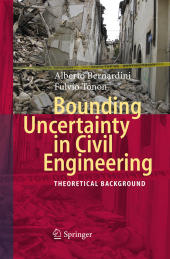 Neuerscheinungen 2014Stand: 2020-02-01 |
Schnellsuche
ISBN/Stichwort/Autor
|
Herderstraße 10
10625 Berlin
Tel.: 030 315 714 16
Fax 030 315 714 14
info@buchspektrum.de |

Alberto Bernardini, Fulvio Tonon
(Beteiligte)
Bounding Uncertainty in Civil Engineering
Theoretical Background
2010. 2014. x, 322 S. 235 mm
Verlag/Jahr: SPRINGER, BERLIN; SPRINGER BERLIN HEIDELBERG 2014
ISBN: 3-642-42542-9 (3642425429)
Neue ISBN: 978-3-642-42542-4 (9783642425424)
Preis und Lieferzeit: Bitte klicken
Taking an engineering approach rather than a mathematical one, this book presents the basic ideas and methods of Random Sets in Civil Engineering with the aid of simple worked-out examples and suggested problems. It offers a gentle introduction to the subject.
Taking an engineering, rather than a mathematical, approach, Bounding uncertainty in Civil Engineering - Theoretical Background deals with the mathematical theories that use convex sets of probability distributions to describe the input data and/or the final response of systems. The particular point of view of the authors is centered on the applications to civil engineering problems, and the theory of random sets has been adopted as a basic and relatively simple model. However, the authors have tried to elucidate its connections to the more general theory of imprecise probabilities, Choquet capacities, fuzzy sets, p-boxes, convex sets of parametric probability distributions, and approximate reasoning both in one dimension and in several dimensions with associated joint spaces. If choosing the theory of random sets may lead to some loss of generality, it has, on the other hand, allowed for a self-contained selection of the topics and a more unified presentation of the theoretical contents and algorithms. With over 80 examples worked out step by step, the book should assist newcomers to the subject (who may otherwise find it difficult to navigate a vast and dispersed literature) in applying the techniques described to their own specific problems.
Motivation.- Review of Theory of Probability and Notation.- Random Sets and Imprecise Probabilities.- Random Relations.- Inclusion and Mapping of Random Sets/Relations.- Approximate Reasoning.


